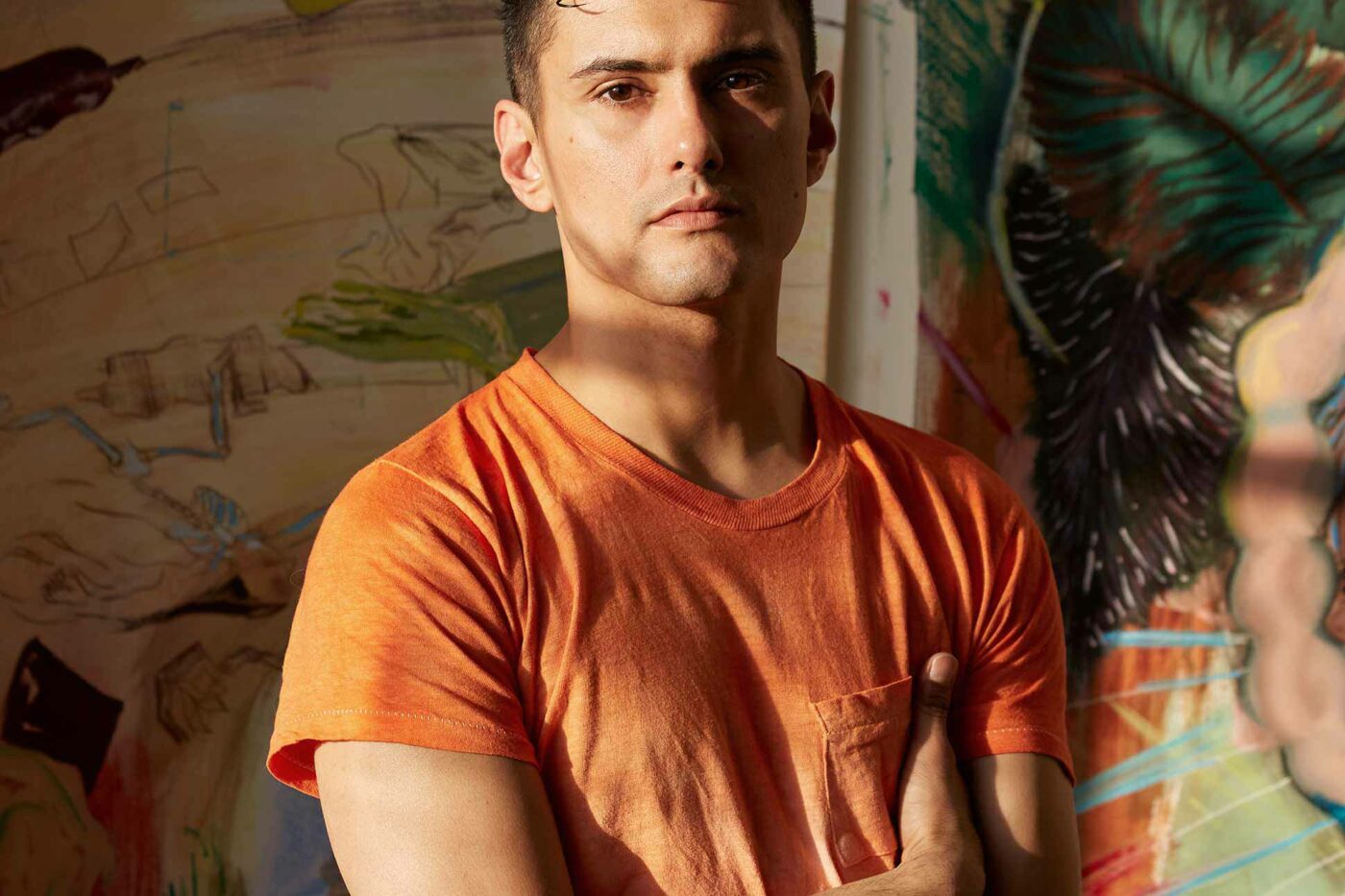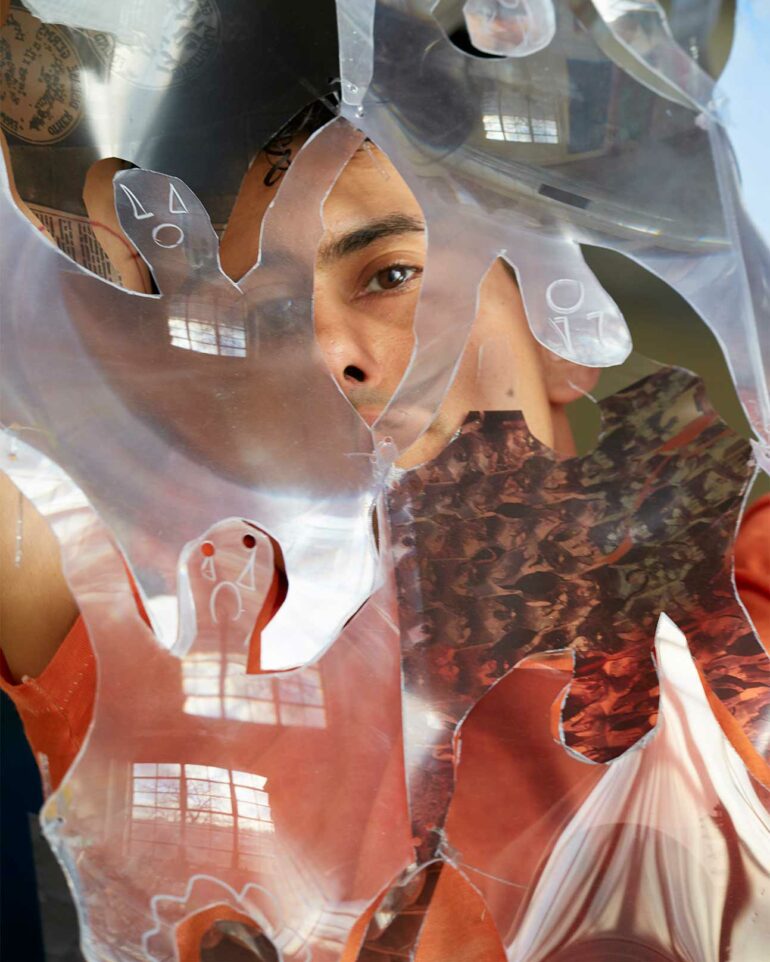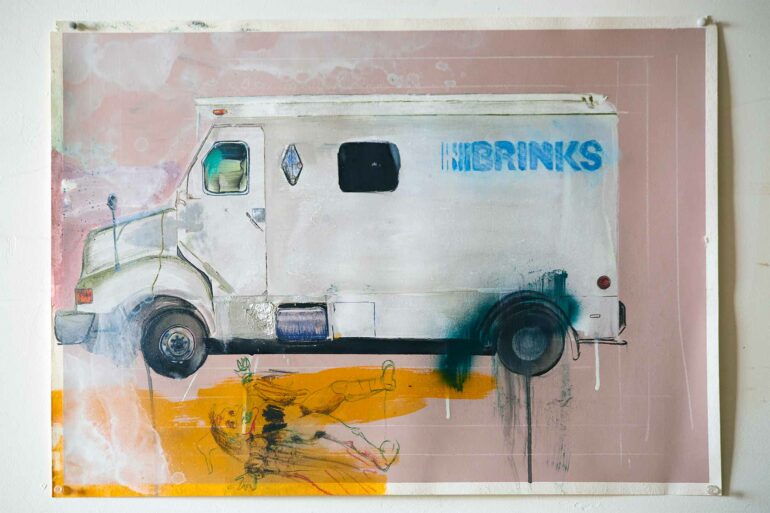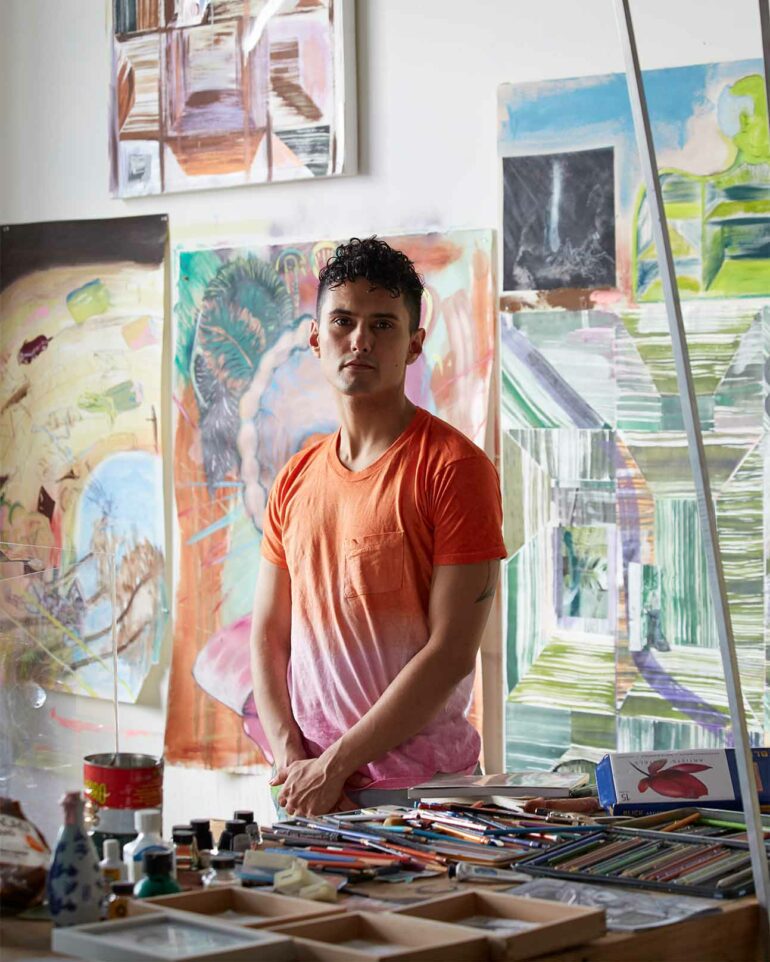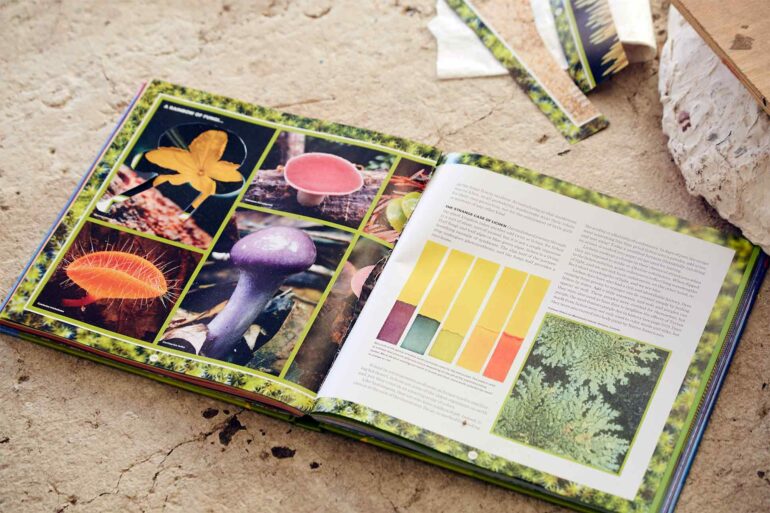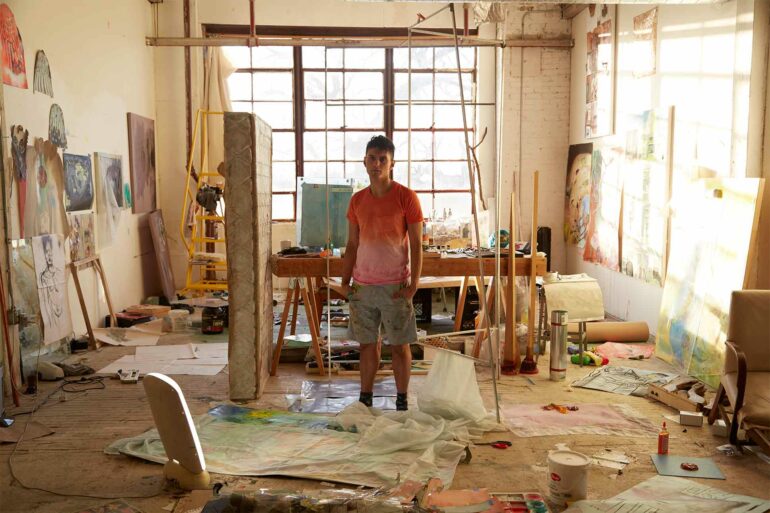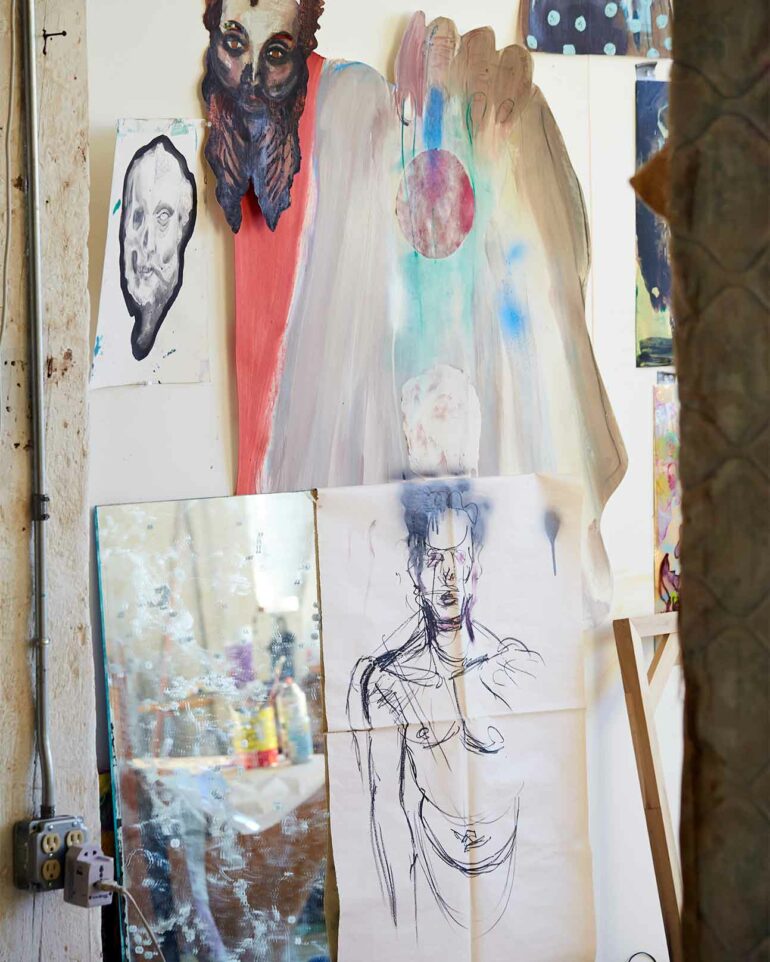“I’m a real irritable asshole; I don’t know what’s wrong with me. I can’t share a studio space with anyone else. I need to masturbate; I need to do crazy things like pee into cups,” shouts Stevie Hanley, the intense young man to me, from the other end of his expansive art studio, as he busies himself looking for a (hopefully clean) coffee cup so we can have a brew.
I cast my eye around the room. It’s hard to settle on one particular thing amongst the colourful detritus strewn across every available surface. Half-finished paintings and drawings plaster the walls; open sketchbooks lie on the floor; a tall but flimsy metal structure in the middle of the room creates a Francis Bacon-esque, three-dimensional frame around the space beyond. To my left, a dizzying heap of lenticular plastic, cut into amorphous shapes, cascades off a sizeable, wooden workbench. Any spare gap between these works of art is filled with pots of paint and brushes. It’s overwhelming to step into this Aladdin’s cave, rich in colour and detail. It feels like being inside someone’s subconscious.
I first met the Californian-born, Latino artist in Berlin some six or seven years ago – neither of us could quite remember the exact date. As an avid supporter of queer artists and collector of their work, I was duty-bound to fill my boots with the bountiful creativity that was exploding in the city. At the time, it was the city of choice for young creatives from all over the world, drawn in by cheap rents and a defiant sense of freedom that had blossomed there in the decades following the fall of the wall. The energy was palpable. Stevie was one of a group of young creatives who I had gathered together for a shoot in a Neukölln squat. Back then, the whole area was still yet to be gentrified and it felt quite edgy. So, it made perfect sense to find Stevie’s current studio in a converted industrial factory, in an area with a similar vibe, albeit some 7,000 miles away in East Garfield Park, Chicago, Illinois.
“The area houses a lot of cutting-edge artists and galleries,” Stevie explains. “There are probably 120 artists in this building alone, which is one of just three on this street. The galleries, mostly artist-run, are all non-commercial project spaces.”
But while some areas of Chicago are gentrifying, Fulton Market, Pilson, Logan Square and (so far) East Garfield Park have resisted the familiar cycle that has befallen so many other similar post-industrial, artist-heavy districts around the world.
“That’s perhaps because this is a predominately African-American neighbourhood. I think a lot of white people are wary of coming here. Sadly there are a lot of artists here who do not engage with the local community, but for me, that’s a big part of the attraction. I teach part-time at the local school right around the corner, and I try to be involved in the neighbourhood; I go to the community centre across the street and eat in the local restaurants. Something which I have been ridiculed for doing. But I honestly feel that if you respect people, you smile at them, treat everyone you meet like human beings, they will reciprocate and accept you.”
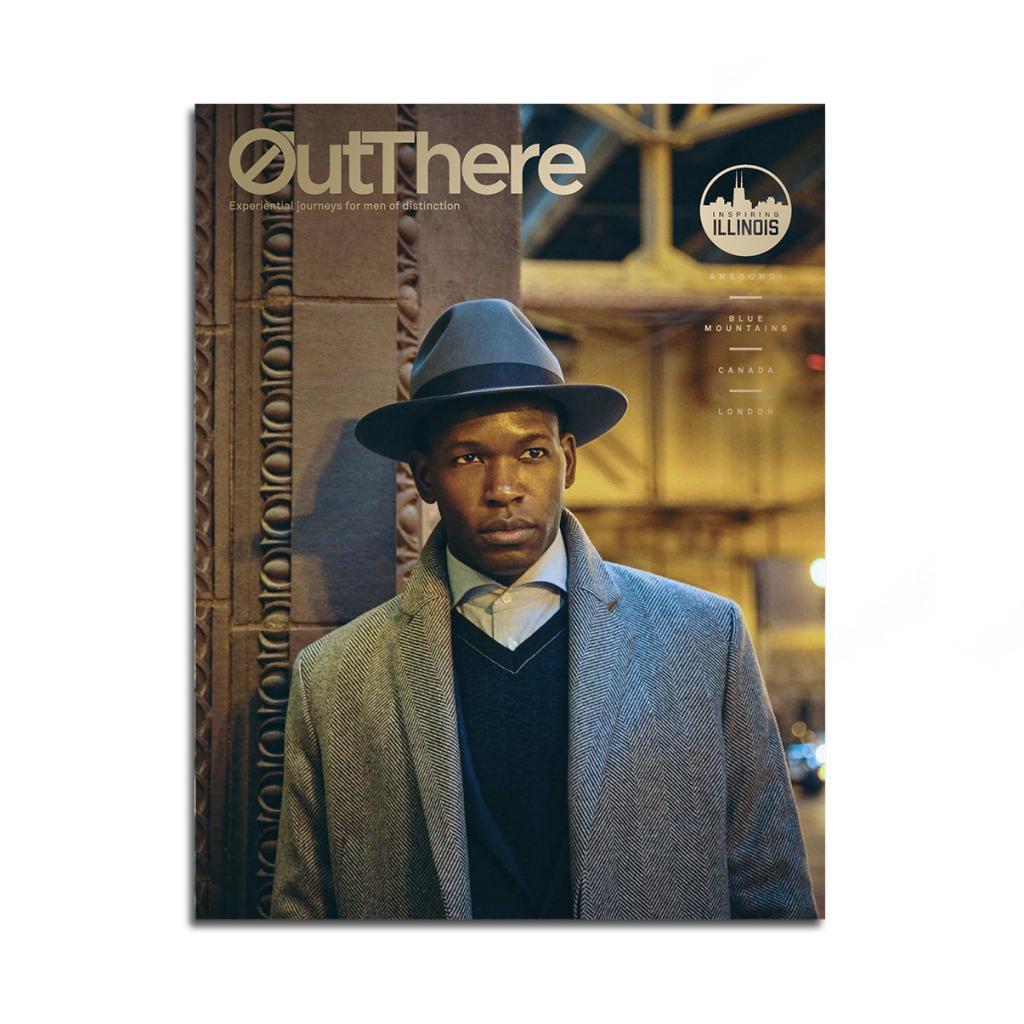
This story first appeared in The Inspiring Illinois Issue, available in print and digital.
Subscribe today or purchase a back copy via our online shop.
It saddens me to hear that other artists come into East Garfield Park and act like they are going to Mars, as Stevie puts it. They drive in and drive out again, without really talking to or interacting with the local community.
“I’ve had no problems in this neighbourhood. I feel safe. But I’m also a man; so perhaps it might be different if I were female, I guess. I also look Latino, or possibly even Middle Eastern, so maybe that helps me to blend into a place that is full of people of colour. I feel like I’m putting my foot in my mouth when I talk about racism to outsiders, but I would rather say something offensive than not talk about it at all. I think it’s important to have these conversations. Race is a huge and polarising issue in this country and I don’t think it does any good not talking about it. I’m a part of this society which is systematically racist and sexist, and I want to transcend that. The only way to do that is to put it out there.”
This passionate response is typical of this intense and earnest young man. While so many of his contemporaries are happy to game the system to move on up, Stevie has far more integrity, a quality which has led him to this current stage in his career.
“One reason I left Berlin was that I was afraid I was getting too commercial. I was selling work, and I was becoming known for my corner paintings. I was making most of my living off my work, but I saw myself selling it just to feed myself and listening to collectors. I feared that I was being pigeonholed. Coming here was almost like starting over. Becoming a student again was a humbling experience.”
Stevie won a scholarship to do a Masters in Painting and Drawing at the School of the Art Institute of Chicago (SAIC), where he now teaches.
“In Chicago, there is a solid painting community, much of which is concerned with abstraction. Which I think has a lot of that has to do with the SAIC. They are real champions for contemporary abstraction. And that’s probably one of the main reasons I was accepted on to the course. I guess my work fits into the tradition of artists like Robert Rauschenberg.”
But moving back to the States wasn’t without its challenges. He had a hard time, and in his first year destroyed everything and rebooted his work.
“I wanted to explore more sculptural aspects, but I hadn’t explicitly studied sculpture so was lacking confidence and skills. I discussed this with one of my first advisors here, Michiko Itatani, who told me to just make a series of bad sculptures, which was very freeing. I stopped worrying about making perfect, finished pieces of work and started experimenting and learning new skills. Her words reminded me of what my old professor said years ago – about how a good physicist can have three ideas every day, but at the end of the year, only one might prove successful. I think you have to have that sort of mentality to be an artist. To give yourself licence to just throw the ideas out there. To acknowledge that there are no bad ideas. Having my studio is a big part of that; it is my safe space, where anything can happen. A lot of it is total shit, but I think if an artist is inhibited, it shows. People can sense that you’re making moves you aren’t confident with.”
The evidence of this willingness to experiment is everywhere in Hanley’s studio. His work spans different media and approaches and the abundance of cheap studio space that Chicago offers is clearly important to him. Moving here, and having a large space to work in – unfettered by financial pressures – along with the city’s healthy art ‘eco-system’, have meant that he has grown and developed as an artist, possibly in ways that he may never have done in somewhere like New York City.
As much as Stevie allows himself the freedom to experiment, he can also filter out the work that needs to be taken to another level.
“An artist can have different states of mind; there’s creative time, and there’s a time to be more critical, to say, ‘ok that didn’t work!’”
In the time that he has been in Chicago, Stevie has had some successful shows in high profile spaces in the city, including the International Museum of Surgical Science and Google’s headquarters. He also maintains strong, avant-garde credentials, by showing at galleries like the Julius Caesar, who have a reputation for featuring the cream of Chicago’s emerging artists. It’s places like this that make Chicago an exciting prospect for artists and collectors looking to invest in fresh talent before they are picked up on the bigger stage. If you know where to look, you can find some fantastic work for relatively little money. In return, you get to have that warm fuzzy feeling that comes with knowing that you are helping to support someone’s career.
One of the things that excites me most about the younger generation is their ability to create their opportunities and in turn, build communities. Stevie is a shining example of how to do both. In addition to making and showing his work, Hanley is invested in facilitating the work of other young queer artists. In 2017, he set up a collectively run arts space, The Condo Association in Humboldt Park.
“When I was a young art student in California, one of my tutors, Verónica de Jesus, said to me that it is vital for artists to figure out a way to show their work. They shouldn’t wait around for galleries to take an interest, they should show in bathrooms, or their living rooms – I’m a real proponent of that idea. I think that it is really important for people to see the work; and to make that happen sometimes, you have to that in your front room.”
As someone who strongly believes in LGBTQ culture, it is encouraging to see that there is something like The Condo Association that is dedicated to pushing queer interests in Chicago.
“We’re unapologetically focused on queer art, and show a lot of sex-positive work,” Stevie explains with typical enthusiasm. “We want to take on fiercely queer projects that you won’t find in another gallery in Chicago, or America for that matter. Part of our ethos is to create a queer space in form as well as function, so it’s nothing like a pretty, commercial gallery. I’ve just curated a big show on bottoming, called ‘God Bottom’. Before that, we hosted an evening of guided masturbation and meditation.”
Despite the unconventional approach, they’ve worked their way into the city’s cultural life and pricked the consciousness of the mainstream media.
“Our first official show got written about in the Chicago Tribune. They announced us as the only explicitly queer gallery in the city, and a lot of people were excited for that. I guess our success is because Chicago’s LGBTQ community is so big. It’s the gay metropolis of the whole mid-west area. It’s also surprisingly sex-positive, which I had no idea about before I came. It’s the home of International Man of Leather (IML) and there are a lot of bars in Chicago that have darkrooms and cruising areas. Back in California, it was illegal. So I’d never heard of that until I moved to Berlin.”
Another surprise to many people, Hanley continues, is the city’s gay beaches. “On the South Side, which is predominantly African-American, there is Rainbow beach, where they hold Black Gay Pride. And in the north in Edgewater, there is Kathy Osterman Beach (or Hollywood Beach). I was living here for about two years before I discovered it for myself, but now I try to spend as much time there in the summer as I can. There are waves, just like the ocean and it’s beautiful and pleasant. Chicago can get very hot and humid so having the beach is wonderful; you can drink and get food and there are hundreds of gay men and queers just hanging out.”
It seems to me that Stevie is doing everything right. He has managed to carve out a life for himself that nurtures his art and yet remain financially independent. He does this while facilitating both the talents of others and helping to create a progressive, enlightened community. His story is typical of the people I have met here. It seems to be somewhere that not only champions artistic endeavour but has a notable lack of pretence and values community.
Throughout history, artists have needed a number of things to create interesting work. They need space and time to develop, an artistic community within which they can construct a critical dialogue and the means to share and sell their work. Hanley has found this in Chicago and what he didn’t find, he has helped to create. In my book, that makes him someone worth watching, not just as a highly investable artist, but as a linchpin for a wider artistic community. Any serious collector will have already added Chicago to their watch-list, but for those looking to start, my tip is to invest in the city’s blossoming talent.
Photography by Martin Perry


